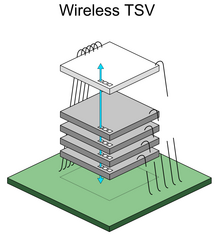Network on a chip
| Part of a series on | ||||
| Network science | ||||
|---|---|---|---|---|
| Network types | ||||
|
||||
| Graphs | ||||
|
||||
| Models | ||||
|
||||
| ||||
A network on a chip or network-on-chip (NoC
NoC technology applies the theory and methods of computer networking to on-chip communication and brings notable improvements over conventional bus and crossbar communication architectures. Networks-on-chip come in many network topologies, many of which are still experimental as of 2018. [citation needed]
In 2000s, researchers had started to propose a type of on-chip interconnection in the form of
Structure
This section needs expansion. You can help by adding to it. (October 2018) |
NoCs can span synchronous and asynchronous clock domains, known as
Architectures
This section needs expansion. You can help by adding to it. (October 2018) |
NoC architectures typically model
Topology
The topology determines the physical layout and connections between nodes and channels. The message traverses hops, and each hop's channel length depends on the topology. The topology significantly influences both latency and power consumption. Furthermore, since the topology determines the number of alternative paths between nodes, it affects the network traffic distribution, and hence the network bandwidth and performance achieved.[5]
Benefits
Traditionally, ICs have been designed with dedicated
Sparsity and locality of interconnections in the communications subsystem yield several improvements over traditional bus-based and crossbar-based systems.
Parallelism and scalability
The wires in the links of the network-on-chip are shared by many
Current research

Some researchers[
This may indicate that for many
Many challenging research problems remain to be solved at all levels, from the physical link level through the network level, and all the way up to the system architecture and application software. The first dedicated research symposium on networks on chip was held at Princeton University, in May 2007.[7] The second IEEE International Symposium on Networks-on-Chip was held in April 2008 at Newcastle University.
Research has been conducted on integrated optical waveguides and devices comprising an optical network on a chip (ONoC).[8][9]
The possible way to increasing the performance of NoC is use wireless communication channels between
Side benefits
In a multi-core system, connected by NoC, coherency messages and cache miss requests have to pass switches. Accordingly, switches can be augmented with simple tracking and forwarding elements to detect which cache blocks will be requested in the future by which cores. Then, the forwarding elements multicast any requested block to all the cores that may request the block in the future. This mechanism reduces cache miss rate.[11]
Benchmarks
NoC development and studies require comparing different proposals and options. NoC traffic patterns are under development to help such evaluations. Existing NoC benchmarks include NoCBench and MCSL NoC Traffic Patterns.[12]
Interconnect processing unit
An interconnect processing unit (IPU).
See also
- Arteris
- Electronic design automation (EDA)
- Integrated circuit design
- CUDA
- Globally asynchronous, locally synchronous
- Network architecture
Notes
- indefinite article corresponding to NoC ("a NoC"). Other sources may pronounce it as /ˌɛnˌoʊˈsiː/ en-oh-SEEand therefore use "an NoC".
References
- ISBN 978-0-7695-0537-4. Archivedfrom the original on 2022-10-22. Retrieved 2022-11-23.
- )
- doi:10.1109/2.976921. Archivedfrom the original on 2022-10-22. Retrieved 2022-11-23.
- OCLC 895661009.
- ^ Staff, E. D. N. (2023-07-26). "Network-on-chip (NoC) interconnect topologies explained". EDN. Retrieved 2023-11-17.
- ^ "Balancing On-Chip Network Latency in Multi-Application Mapping for Chip-Multiprocessors". IPDPS. May 2014.
- ^ NoCS 2007 Archived 2008-09-01 at the Wayback Machine website.
- ^ On-Chip Networks Bibliography
- ^ "Inter/Intra-Chip Optical Network Bibliography-". Archived from the original on 2015-09-23. Retrieved 2015-07-02.
- ^ Slyusar V. I., Slyusar D.V. Pyramidal design of nanoantennas array. // VIII International Conference on Antenna Theory and Techniques (ICATT'11). - Kyiv, Ukraine. - National Technical University of Ukraine "Kyiv Polytechnic Institute". - September 20–23, 2011. - Pp. 140–142. [1] Archived 2019-07-17 at the Wayback Machine
- ^ "NoC traffic". www.ece.ust.hk. Archived from the original on 2017-12-25. Retrieved 2018-10-08.
- ISBN 978-1-4200-4471-3
Adapted from Avinoam Kolodny's's column in the ACM SIGDA e-newsletter by Igor Markov
The original text can be found at http://www.sigda.org/newsletter/2006/060415.txt
Further reading
- Kundu, Santanu; Chattopadhyay, Santanu (2014). Network-on-chip: the Next Generation of System-on-Chip Integration (1st ed.). Boca Raton, FL: CRC Press. OCLC 895661009.
- Sheng Ma; Libo Huang; Mingche Lai; Wei Shi; Zhiying Wang (2014). Networks-on-Chip: From Implementations to Programming Paradigms (1st ed.). Amsterdam, NL: Morgan Kaufmann. OCLC 894609116.
- Giorgios Dimitrakopoulos; Anastasios Psarras; Ioannis Seitanidis (2014-08-27). Microarchitecture of Network-on-Chip Routers: A Designer's Perspective (1st ed.). New York, NY. )
- Natalie Enright Jerger; Tushar Krishna; Li-Shiuan Peh (2017-06-19). On-chip Networks (2nd ed.). San Rafael, California. )
- Marzieh Lenjani; Mahmoud Reza Hashemi (2014). "Tree-based scheme for reducing shared cache miss rate leveraging regional, statistical and temporal similarities". IET Computers & Digital Techniques. 8: 30–48. .
External links
- DATE 2006 workshop on NoC
- NoCS 2007 - The 1st ACM/IEEE International Symposium on Networks-on-Chip
- NoCS 2008 - The 2nd IEEE International Symposium on Networks-on-Chip
- Jean-Jacques Lecler, Gilles Baillieu, Design Automation for Embedded Systems (Springer), "Application driven network-on-chip architecture exploration & refinement for a complex SoC", June 2011, Volume 15, Issue 2, pp 133–158, doi:10.1007/s10617-011-9075-5 [Online] http://www.arteris.com/hs-fs/hub/48858/file-14363521-pdf/docs/springer-appdrivennocarchitecture8.5x11.pdf

